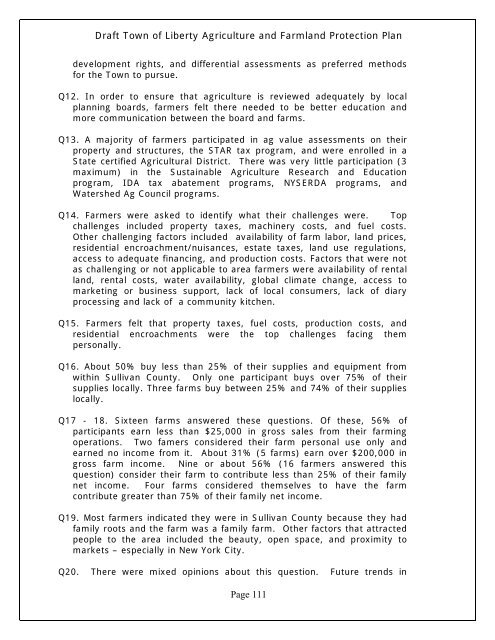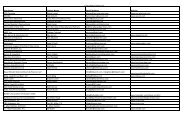Agriculture and Farmland Protection Plan - Town of Liberty
Agriculture and Farmland Protection Plan - Town of Liberty
Agriculture and Farmland Protection Plan - Town of Liberty
Create successful ePaper yourself
Turn your PDF publications into a flip-book with our unique Google optimized e-Paper software.
Draft <strong>Town</strong> <strong>of</strong> <strong>Liberty</strong> <strong>Agriculture</strong> <strong>and</strong> Farml<strong>and</strong> <strong>Protection</strong> <strong>Plan</strong><br />
development rights, <strong>and</strong> differential assessments as preferred methods<br />
for the <strong>Town</strong> to pursue.<br />
Q12. In order to ensure that agriculture is reviewed adequately by local<br />
planning boards, farmers felt there needed to be better education <strong>and</strong><br />
more communication between the board <strong>and</strong> farms.<br />
Q13. A majority <strong>of</strong> farmers participated in ag value assessments on their<br />
property <strong>and</strong> structures, the STAR tax program, <strong>and</strong> were enrolled in a<br />
State certified Agricultural District. There was very little participation (3<br />
maximum) in the Sustainable <strong>Agriculture</strong> Research <strong>and</strong> Education<br />
program, IDA tax abatement programs, NYSERDA programs, <strong>and</strong><br />
Watershed Ag Council programs.<br />
Q14. Farmers were asked to identify what their challenges were. Top<br />
challenges included property taxes, machinery costs, <strong>and</strong> fuel costs.<br />
Other challenging factors included availability <strong>of</strong> farm labor, l<strong>and</strong> prices,<br />
residential encroachment/nuisances, estate taxes, l<strong>and</strong> use regulations,<br />
access to adequate financing, <strong>and</strong> production costs. Factors that were not<br />
as challenging or not applicable to area farmers were availability <strong>of</strong> rental<br />
l<strong>and</strong>, rental costs, water availability, global climate change, access to<br />
marketing or business support, lack <strong>of</strong> local consumers, lack <strong>of</strong> diary<br />
processing <strong>and</strong> lack <strong>of</strong> a community kitchen.<br />
Q15. Farmers felt that property taxes, fuel costs, production costs, <strong>and</strong><br />
residential encroachments were the top challenges facing them<br />
personally.<br />
Q16. About 50% buy less than 25% <strong>of</strong> their supplies <strong>and</strong> equipment from<br />
within Sullivan County. Only one participant buys over 75% <strong>of</strong> their<br />
supplies locally. Three farms buy between 25% <strong>and</strong> 74% <strong>of</strong> their supplies<br />
locally.<br />
Q17 - 18. Sixteen farms answered these questions. Of these, 56% <strong>of</strong><br />
participants earn less than $25,000 in gross sales from their farming<br />
operations. Two famers considered their farm personal use only <strong>and</strong><br />
earned no income from it. About 31% (5 farms) earn over $200,000 in<br />
gross farm income. Nine or about 56% (16 farmers answered this<br />
question) consider their farm to contribute less than 25% <strong>of</strong> their family<br />
net income. Four farms considered themselves to have the farm<br />
contribute greater than 75% <strong>of</strong> their family net income.<br />
Q19. Most farmers indicated they were in Sullivan County because they had<br />
family roots <strong>and</strong> the farm was a family farm. Other factors that attracted<br />
people to the area included the beauty, open space, <strong>and</strong> proximity to<br />
markets – especially in New York City.<br />
Q20. There were mixed opinions about this question. Future trends in<br />
Page 111




